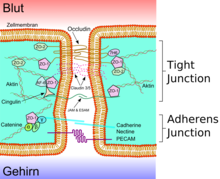Junctional Adhesion Molecules
Junctional Adhesion Molecule (JAM) (“junctional adhesion molecule”, Latin iunction = “connection”) are proteins that belong to a subgroup of the immunoglobulin superfamily . They consist of 2 immunoglobulin-like domains, a transmembrane domain and a short cytoplasmic domain. They are only present in vertebrates.
JAMs are expressed by a variety of different cells. They are mainly found in epithelial cells, endothelial cells and cells of the immune system (leukocytes), but also in cells of the central and peripheral nervous system, male germ cells and Sertoli cells.
In epithelial cells and endothelial cells, the junctional adhesion molecules are part of the tight junctions . Within the cytoplasm of the JAM are with the actin - cytoskeleton connected.
family members
So far, three junctional adhesion molecules with about 300 to 310 amino acids are known. Two other immunoglobulins with around 400 amino acids and the same function can be added.
JAM-A
JAM-A ( Gene Name: F11R ) was the first Junctional Adhesion Molecule to be discovered. JAM-A is mainly expressed in the tight junctions of epithelial and endothelial cells. It plays a key role in the migration of leukocytes. It is also involved in antibody- induced platelet aggregation .
JAM-B
JAM-B (also CD322, gene name: JAM2 ) plays an important role in the transmigration of lymphocytes through the endothelium. JAM-B was first described in 2001 and is expressed on endothelia and lymphatic cells . It consists of 298 amino acids .
JAM-C
JAM-C (gene name: JAM3 ) is the third junctional adhesion molecule known to date. The gene coding for this protein is located in humans on chromosome 11 gene locus q25. In addition to endothelial and epithelial cells, JAM-C is also expressed in fibroblasts , smooth muscle cells , spermatids and peripheral nerve cells. AM-like
JAM-like (gene name: AMICA1 ) has a similar function to JAM-B and is expressed in hematopoietic and liver cells.
IGSF5
IGSF5 also functions in tight junctions, particularly possibly in the glomeruli of the kidneys and in the small intestine . It also has a role in sperm cell adhesion.
References and footnotes
- ↑ Note: This term is hardly used in the German-language specialist literature, in contrast to the English-language name.
- ↑ Ebnet K (2017) Junctional Adhesion Molecules (JAMs): Cell Adhesion Receptors With Pleiotropic Functions in Cell Physiology and Development. Physiol Rev. 2017 Oct 1; 97 (4): 1529-1554. doi : 10.1152 / physrev.00004.2017 . PMID 28931565 .
- ↑ P. Florian: Restitution of single cell lesions in the colonic epithelium. Dissertation, FU Berlin, 2002. urn : nbn: de: kobv: 188-2002003079
- ↑ Bazzoni G: The JAM family of junctional adhesion molecules . In: Curr. Opin. Cell Biol . 15, No. 5, October 2003, pp. 525-30. PMID 14519386 .
- ^ Naik UP, Eckfeld K: Junctional adhesion molecule 1 (JAM-1) . In: J. Biol. Regul. Homeost. Agents . 17, No. 4, 2003, pp. 341-7. PMID 15065765 .
- ↑ Aurrand-Lions M, Johnson-Leger C, Lamagna C, Ozaki H, Kita T, Imhof BA: Junctional adhesion molecules and interendothelial junctions . In: Cells Tissues Organs . 172, No. 3, 2002, pp. 152-60. PMID 12476045 .
- ↑ Aurrand-Lions M, Duncan L, Ballestrem C, Imhof BA: JAM-2, a novel immunoglobulin superfamily molecule, expressed by endothelial and lymphatic cells . In: J. Biol. Chem. . 276, No. 4, January 2001, pp. 2733-41. doi : 10.1074 / jbc.M005458200 . PMID 11053409 .
- ↑ Morris AP, Tawil A, Berkova Z, Wible L, Smith CW, Cunningham SA: Junctional Adhesion Molecules (JAMs) are differentially expressed in fibroblasts and co-localize with ZO-1 to adherens-like junctions . In: Cell Commun. Adhes. . 13, No. 4, 2006, pp. 233-47. doi : 10.1080 / 15419060600877978 . PMID 16916751 .
- ↑ Keiper T, Al-Fakhri N, Chavakis E, et al. : The role of junctional adhesion molecule-C (JAM-C) in oxidized LDL-mediated leukocyte recruitment . In: FASEB J . . 19, No. 14, December 2005, pp. 2078-80. doi : 10.1096 / fj.05-4196fje . PMID 16195363 .
- ↑ Gliki G, Ebnet K, Aurrand-Lions M, Imhof BA, Adams RH: Spermatid differentiation requires the assembly of a cell polarity complex downstream of junctional adhesion molecule-C . In: Nature . 431, No. 7006, September 2004, pp. 320-4. doi : 10.1038 / nature02877 . PMID 15372036 .
- ↑ Scheiermann C, Meda P, Aurrand-ion M, et al. : Expression and function of junctional adhesion molecule-C in myelinated peripheral nerves . In: Science . 318, No. 5855, November 2007, pp. 1472-5. doi : 10.1126 / science.1149276 . PMID 18048693 .
- ↑ Moog-Lutz C, Cavé-Riant F, Guibal FC, et al. : JAML, a novel protein with characteristics of a junctional adhesion molecule, is induced during differentiation of myeloid leukemia cells . In: Blood . 102, No. 9, November 2003, pp. 3371-8. doi : 10.1182 / blood-2002-11-3462 . PMID 12869515 .
- ↑ UniProt Q9NSI5
literature
- Ouwehand, WH: Cell surface interactions at the vascular wall . In: EBI (Ed.): Reactome.org . November 12, 2007, doi : 10.3180 / REACT_12051.1 ( reactome.org ).
